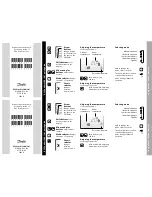
Ascon Tecnologic - e33B - OPERATING INSTRUCTIONS - PAG. 11
5.9
Evaporator fans control
The control of the evaporator fans on the output configured as
Fn
depends on some specific control statuses of the instrument
and the temperature measured by the evaporator probe (
EP
).
In the case that the evaporator probe is not used or in error,
the
Fn
output is activated only depending on parameters
Ftn
,
FtF
and
FFE
.
Parameters
Ftn
and
FtF
can be used to determine the behavior
of the evaporator fans when the
ot
outupt (compressor) is
OFF
.
When
ot
output is
OFF
, it is possible to set the instrument so
that that the
Fn
output continues working in cycles according
to the times programmed at parameters
Ftn
(fan activation
time) and
FtF
(fan deactivation time).
When output
ot
is switched
OFF
the instrument activates the
output
Fn
for the time
Ftn
, then deactivates it for the time
FtF
and so on whilst the otuput
ot
remains
OFF
.
Programming
Ftn
=
oF
the output
Fn
in
ot
OFF
condition
remains switched
OFF
.
Programming instead
Ftn
to any value and
FtF
=
oF
the
output
Fn
when
ot
in
OFF
condition remains switched
ON
.
The parameter
FFE
decides whether the fans must always
be switched
ON
independently of the defrosting status
(
FFE
=
on
) or switched
OFF
during defrosting (
FFE
=
oF
).
In this later case, it is possible to delay the start up of the
fans even after the end of the defrost by the time set at
FFd
parameter. When this delay is active the LED flashes to
point out that the
FFd
delay is in progress.
When the evaporator probe is used the fans, as well as be-
ing conditioned by the parameters
Ftn
,
FtF
and
FFE
, are
also conditioned by a temperature control.
FLF
FFL
Temp.
FdF
FdF
time
off
off
off
ON
ON
Ep
Fan
Note:
It is necessary to pay attention to the correct use of
this fans temperature control functions because in
the typical application of refrigeration the stop of the
evaporator fans stops also the thermal exchange.
Remember that the fans functioning can be conditioned by
the
Door open
function by the digital input.
5.10 Alarm functions
The alarm conditions of the instrument are:
–
Probe errors
E1
,
-E1
,
E2
,
-E2
and
E3
,
-E3
;
–
Temperature alarms
Hi
and
Lo
;
–
External alarm
AL
;
–
Door open
oP
.
The alarm functions acts on LED , on the internal buzzer,
if present and configured by the
obu
parameter and on the
desired output if configured by parameters
oo1
,
oo2
or
oo3
.
Any active alarm condition is signaled lighting up the LED ,
while the acknowledged alarm status is shown by flashing the
LED .
The buzzer (if present) can be configured to point out the alarms
by programming parameter
obu
=
1
or
3
and always acts
to signal an acknowlegeable alarm. This means that, when
activated, it can be switched
OFF
by briefly pressing any key.
Also outputs can operate to signal alarms as specified by
the output configuration parameters settings that follow. The
possible selections of output parameters for the alarm sig-
nalling function are:
At
When the output is to be activated in alarm condition
and can be deactivated manually by pressing any key of
the instrument (typical application for an acoustic signal);
AL
When the output is to be activated in alarm condition
but cannot be deactivated manually; it is then deac-
tivated only when the alarm status ceases (typical
application for a light signal);
An
When the output is to be activated in alarm condition
and that remains active even when the alarm sta-
tus has ceased (stored alarm). The disabling action
(recognition of a stored alarm) can only be carried out
manually by pressing any key only when the alarm
status has been removed.
-t
Functions as the function described with
At
but with
inverse working logic (the output activated in normal
condition and disabled in alarm status).
-L
This alarm function is similar to
AL
but with inverse
working logic (output active in normal conditions and
disabled in alarm status).
-
n
This alarm function is similar to
An
but with inverse
working logic (output active in normal conditions and
disabled in alarm status).
The instrument offers the possibility to have the alarm
memory function activated via the parameter
AtA
:
oF
The instrument cancels the alarm signal when the
alarm status ends;
on
The instrument maintains the flashing of LED also
when the alarm status ends. To cancel the alarm
memory signal, press any key.
It must be remembered that if an output function is desired
with an alarm memory (
oo1
/
oo2
/
oo3
=
An
/
-n
) it is necessary
to set the parameter
AtA
=
on
.





































